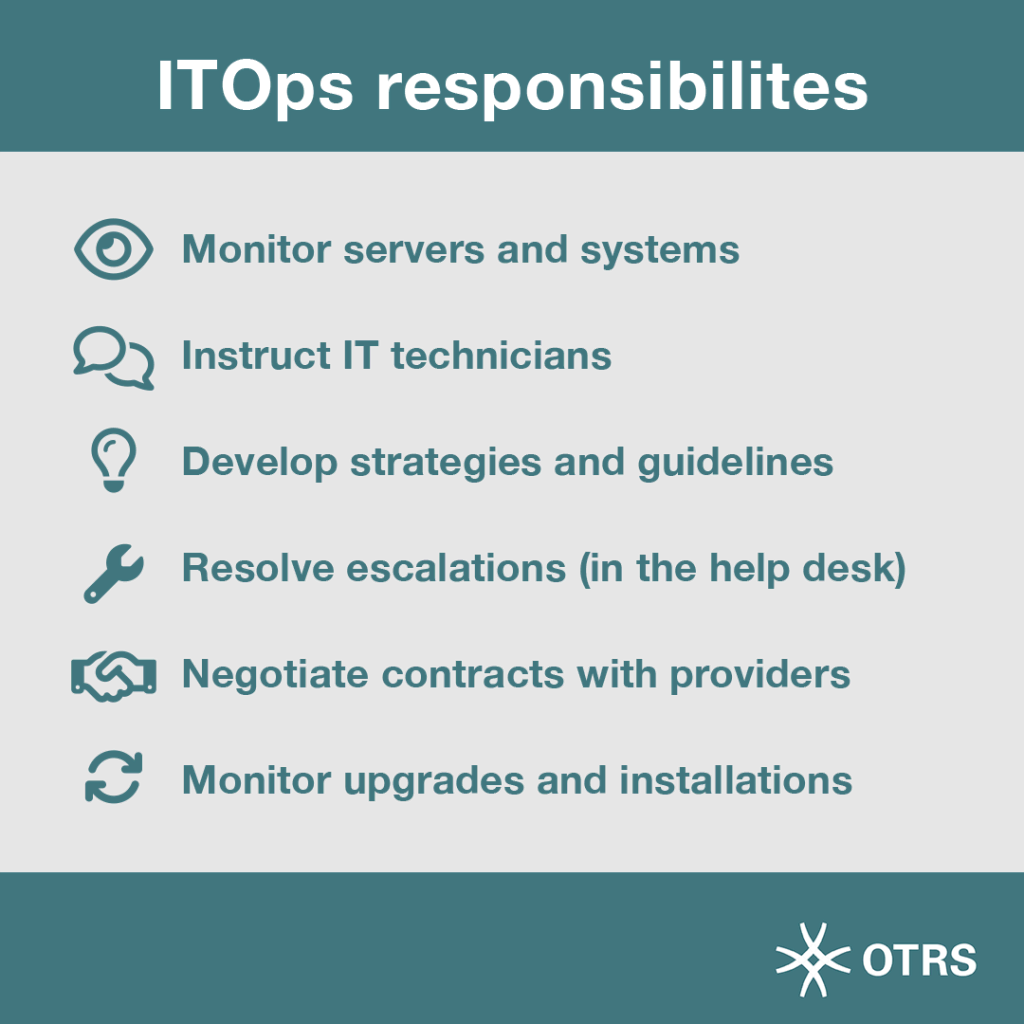
Definition: What is ITOps?
In IT operations, or ITOps, processes and tools are managed. This helps keep the business running smoothly.
The goal is to provide and manage high-quality IT services. These services should be available at all times for both internal and external users.
IT operations must enable companies and their customers to have permanent access to suitable software, cloud solutions, tools and data. It is also responsible for the IT infrastructure, ensuring quick problem solving and high levels of security.
Meaning in ITIL
ITOps is a core area in IT Service Management (ITSM) and defined in the IT Infrastructure Library (ITIL). It is responsible for ensuring that the IT infrastructure and supporting services – both in day-to-day business and during maintenance – function without any problems.
In principle, ITOps covers all ITIL processes. For example, it is important to respond quickly and consistently to incidents in ITIL Incident Management. This helps ensure that ongoing operations are not affected. IT Operations is closely paired with Problem Management to determine the underlying causes of incidents.
ITOM and ITSM
ITOM is the abbreviation for IT Operations Management. It oversees the work of ITOps. It manages services and aligns the IT requirements of a company with the work being done. This leads to quality business operations.
Essentially, ITOM should ensure that the IT infrastructure is ready and permanently available. It also keeps an eye on the capacity and performance of the respective resources.
ITSM falls under ITOM and includes other areas, such as continuous improvement, IT strategy and service design. Sub-disciplines, such as change management, are subordinate to this. ITOM is hardly visible to the end user as it focuses on service management behind the scenes.
Background: A key difference of ITOM is that it is proactive. It does not react to reported incidents, problems or change requests alone. Rather, it works proactively to avoid that incidents in the first place.
In contrast, incident management in ITSM does. With ITOM, IT teams notify users about possible problems ahead of time. This is different from ITSM, where users report incidents to the teams.

Connection with DevOps
ITOps and DevOps both aim to run IT systems reliably and efficiently. However, their roles and responsibilities differ. ITOps enables the stable and smooth functioning of the infrastructure. DevOps enables the agile and collaborative provisioning of software applications.
In a modern IT environment, it is advisable that ITOps and DevOps to work closely together. This ensures that all relevant areas are seamlessly covered. Additionally, they can both benefit from automation and the principle of continuous improvement.
ITOps: areas of application
IT operations have an impact on various processes and factors. This section deals with the individual areas to which they relate.
IT infrastructure
IT Operations enables the IT infrastructure to be efficient, secure, stable, available at all times and scalable. It works to prevent service interruptions.
Infrastructure management also ensures better use of resources. It helps follow guidelines, like compliance, and supports new technologies. By automating and standardizing processes, ITOps builds a strong and cost-effective infrastructure. This infrastructure meets the needs of the company.
Networks
ITOps operates and monitors networks. This involves data center management, security and other factors, such as the hardware used. The network infrastructure and its integrity are very important. Communication, network security, and remote access also play key roles.
- IT Operations monitors and maintains networks so that they are permanently available without outages.
- By sensibly regulating load distribution and managing traffic, ITOps creates good network utilization and speed.
- By implementing firewalls, VPNs or intrusion detection systems, ITOps protects networks from attacks.
- By adapting networks to increasing requirements, ITOps creates scalability – for example through segmentation and cloud-based solutions.
- Rapid responses to network disruptions and root cause analysis help to solve problems and prevent future outages.
Security
IT Operations can prove to be extremely important for security and incident response. For example, by monitoring systems, suspicious activity and threats can be detected at an early stage.
To support this, regular updates and patches can eliminate security gaps. ITOps is also responsible for access controls, encryption techniques and other measures to protect sensitive data. If security incidents have already occurred, incident management restores systems and minimizes damage.
Problem solving
Solving problems adequately is extremely important for IT operations. Ideally, this starts with predicting potential problems and creating opportunities for prevention. Understanding how a specific problem could affect you helps you see how serious it is and how quickly you need to act. If problems do occur, the aim is to respond and recover as quickly as possible.
In general, ITOps should effectively manage ongoing operations as well as possible. This leads to IT weaknesses being handled as well as outages, security incidents and other events being thwarted.
Best practices for IT operations
IT operations should not only function, but also have the best possible impact. After all, it’s about achieving relevant goals, making a difference, and ideally, being efficient in the process.
Analyze and audit data
One thing is certain: Data must form the basis for IT process decisions and business services. Consistent, target-oriented and robust decisions can only be made with accurate data.
This presupposes a number of requirements for data, such as the following:
- Accuracy
- consistency
- comprehensive content
- timeliness
On this basis, meaningful measures can be developed to optimize IT operations.
Evaluate solutions
In order to optimize IT operations, the existing IT landscape should be regularly compared with available solutions. A good knowledge base of internal processes on the one hand and suitable solutions on the other are crucial. Of course, a decision can also be made that the existing IT landscape is already completely sufficient.
In order to arrive at an ideal solution, a dedicated comparison is required:
- What requirements do the IT processes and the status quo entail?
- What are the current ITOM goals? How can they be achieved?
- Which specific solutions fit the requirements and objectives?
Align with KPIs
IT should work – that is already clear. It must also support relevant growth in business services. Its operations have long since become a decisive factor in achieving corporate goals.
This means that IT operations acts as a strategic business unit. To fulfill this role, they should establish KPIs that align with corporate level goals.
Introduce automation
Anything that runs automatically saves effort and costs and frees up time for more value-added and innovative activities. More importantly, however, automation reduces errors and prevents the resulting problems.
However, steps such as process automation or workflow automation must be well thought out and require clear work steps. Anyone who automates a process that is not sufficiently good will duplicate errors and produce them again and again.
Check AI implementations
Increased use of AI is not just a trend. It makes perfect sense in many areas. When used correctly, AI leads to fast and satisfactory results, fewer errors and more time for value-added activities.
AI in ITSM is a pioneering area. It promises benefits such as shorter resolution times, better and more flexible service and increased efficiency.
However, IT teams should carefully evaluate which AI and machine learning solutions promise real improvements. They must understand individual use cases and practical applications.
While AI offers many benefits, practical experience and clear goals are what truly matter. These factors help decide which solutions, tools, services, and features make a real difference.
Embrace collaboration
Collaboration has many benefits. They can only achieve a solid overall result if they collaborate closely with each other.
For IT operations, this applies above all to areas such as DevOps or IT security. It also serves as a partner to the business. Teams should collaborate with various operational teams about needs and expectations.
Team members should take responsibility to collaborate frequently.
Design clear documentation
Clearly documenting configurations, processes and changes is a basic requirement. It is crucial that this is also clear and can be viewed and understood by all those involved via a knowledge base. In practice, missteps and mistakes occur too quickly, so a granular approach is needed.
Plan with scalability in mind
The world is constantly changing, and the IT infrastructure is changing as well. What works today may be inadequate tomorrow. Those responsible need to be aware of this and keep an eye on possible future developments. If the company and the associated IT requirements grow, the infrastructure must reflect this.
Engage in proactive monitoring
Problems don’t usually appear out of nowhere. They announce themselves. When people who monitor systems and services are dedicated and organized, they can find problems quickly. This helps them prevent incidents from happening.
The main point is to keep working on this task in real time. They should aim to stop problems from happening before they start.
ITOps and the use of ticket systems
IT operations is a core area in ITSM. It requires a high level of responsibility as well as a pronounced need for organization, structure and an overview.
By covering these requirements, a ticket system creates efficiency, transparency and traceability. It helps manage areas such as critical processes, problem solutions, service request handling and changes. In short: work is faster and more reliable, which improves the relationship with the business and its customers.
This starts with systematically recording, prioritizing and assigning inquiries and problems. Clear documentation of all processes is very important. It provides a central source of information for key tasks. This includes solving problems and managing changes.
In addition, analyses and statistics integrated into a ticket system can serve to optimize processes. For example, it may bring current or recurring problems to light.
Finally, it improves communication both inside and outside the organization. Users can interact clearly and focus on tasks while staying well-informed.
Conclusion: ITOps – an important pillar for business success
IT operations plays a key role as a core ITSM area. Modern companies are highly dependent on functional and goal-oriented IT. It forms an important pillar of success for companies as a whole.
With many challenges, change requests, detailed security needs, and problems, keeping regular IT operations running is often hard. Aligning IT effectively with KPIs and business goals, introducing meaningful automation and implementing relevant AI complicates the task.
It is therefore clear that those responsible in ITOps have important roles with a high impact. This work needs a clear structure. It can improve a lot with best practices and a good ticket system.
Learn how OTRS can support and optimize your IT operations.
